PREVIOUS
National Symbols of India – Part 1
December 1 , 2023
776 days
162659
0
(இதன் தமிழ் வடிவத்திற்கு இங்கே சொடுக்கவும்)
National Symbols of India
- India has picked various National Symbols at different times that reflect identity.
- National symbols in India depict the rich heritage of its socio-cultural contents.
- These are unique to Indian subcontinent from the rest of the world.
- National symbols of India create the entity of the whole nation, highlighting the pride and prestige.
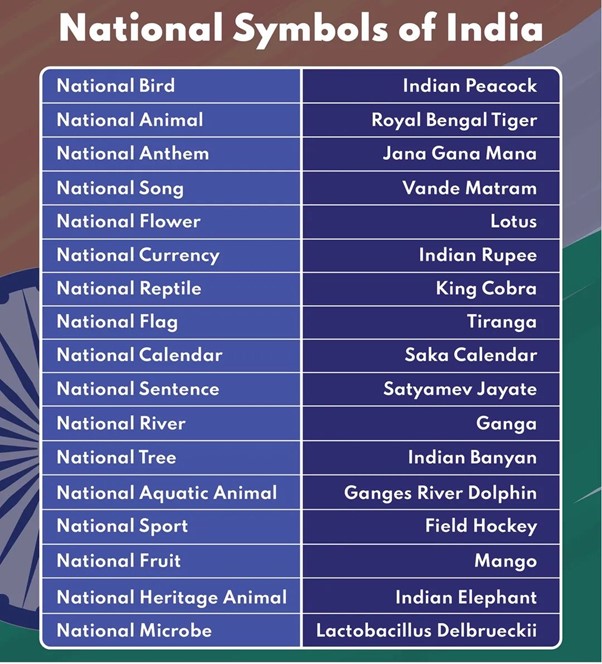
Importance of National Symbols of India
- There are 17 National Symbols of India, namely - Mango, Ganga, Royal Bengal Tiger, Indian Banyan, Tiranga, Jana Gana Mana, Saka Calendar, Vande Mataram, National Emblem of India, Ganges River Dolphin, Indian Peacock, Indian Rupee, King Cobra, Indian Elephant, Lotus, Pumpkin and National Pledge.
- First, they represent the country’s rich cultural heritage.
- They promote a great sense of pride in the hearts of the population of India.
- Be representative of anything particular to India and its people.
- Promote the chosen item to a broader audience.
- Help to safeguard the national symbol for future generations.
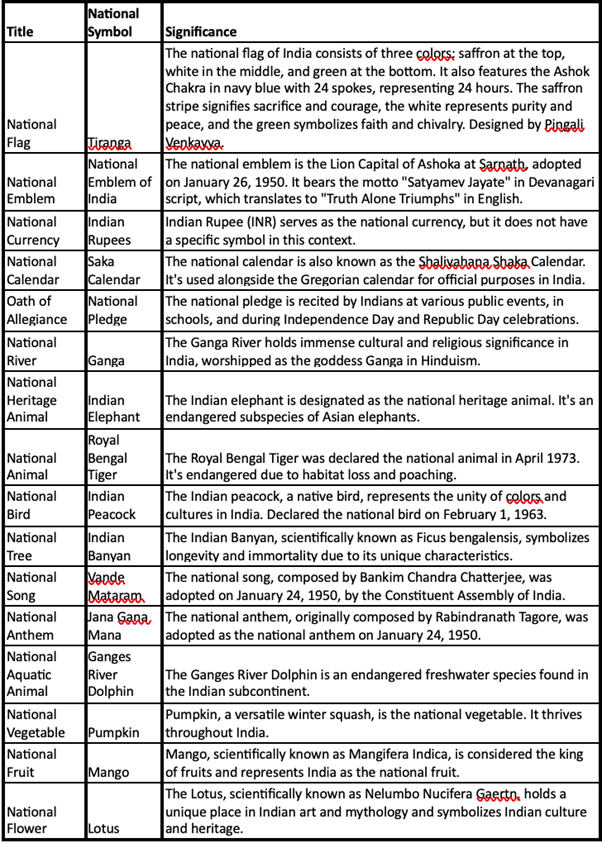
National Flag: Tiranga
- The Indian flag is called the Tiranga.
- The Constituent Assembly approved the flag on July 22, 1947.
- It was created by Pingali Venkayya.
- The saffron-colored flag is a symbol of the country’s power and bravery.
- Peace and honesty are represented by the Dharma Chakra’s white centre band.
- As a symbol of abundance and growth, green has long been associated with a place.
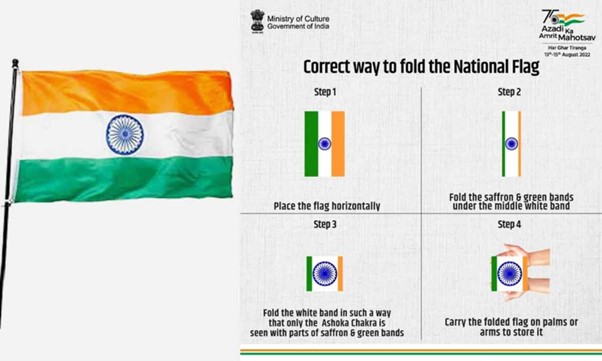
- Sarnath Lion Capital of Ashoka’s Sarnath abacus appears to have inspired its design.
- It is a distinctive wheel with almost the same diameter as the white band and 24 spokes.
- On July 22, 1947, India’s Constituent Assembly approved the country’s national flag design.
National Emblem
- The Indian National Emblem was accepted on 26 January 1950.
- It was designed by Madhav Sawhney.
- It is an adaptation from the Sarnath Lion Capital of Ashoka.
- There is a guiding principle here called Satyameva Jayate (“Truth Alone Triumphs).
- The words Satyameva Jayate (meaning ‘truth alone tirumphs’) from Mundaka Upanishad are inscribed below the abacus in Devanagari script.
- An abacus has four Asiatic lions standing back-to-back on it.
- It is located near Varanasi in Uttar Pradesh.
- Carved out of a single block of polished sandstone, the capital is crowned by the Wheel of the Law (Dharma Chakra).
- The four lions symbolizing power, courage and confidence, rest on a circular abacus.
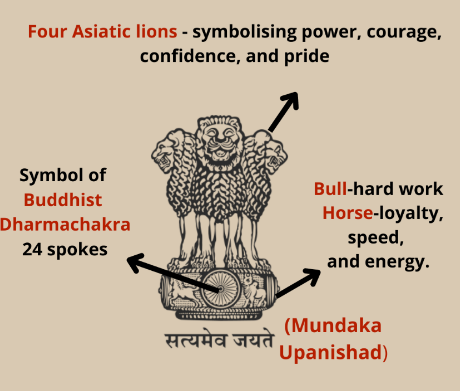
- The abacus is girdled by four smaller animals guardians of the four directions: the lion of the north, the elephant of the east, the horse of the south and the bull of the west.
- The abacus rests on a lotus in full bloom, exemplifying the fountainhead of life and creative inspiration.
- The use of the state emblem of India, as the official seal of the Government of India, is regulated by the State Emblem of India (Prohibition of Improper Use) Act, 2005.
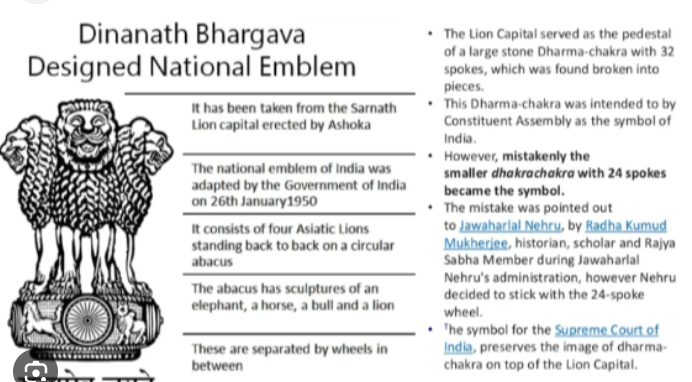
National Calendar: Saka Calendar
- The Indian national calendar is sometimes called the Shalivahana Shaka calendar.
- National Calendar was adopted on 22 March 1957, along with the Gregorian calendar.
- When the Calendar Committee first unveiled the Saka Calendar in 1957, it was widely regarded as a revolutionary timepiece.
- As per National Calendar, the months names are Chaitra, Vaishakh, Jyaishtha, Ashadha, Shravana, Bhadrapad, Ashwin, Kartik, Agrahayana, Pausha, Magha, and Phalguna.
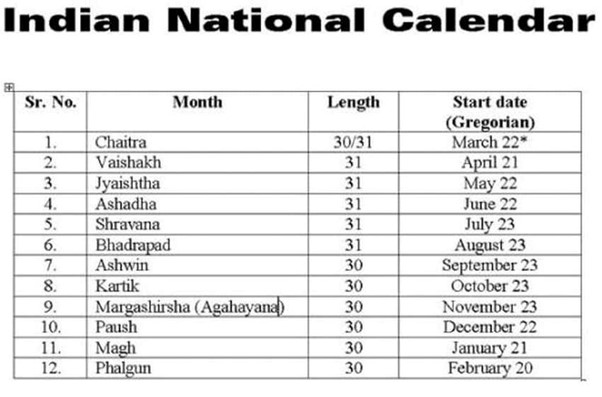
National Anthem: Jana Gana Mana
- A rendition of the Indian national anthem Rabindranath Tagore’s Bengali-language composition.
- Jana-Gana-Mana was declared the National Anthem of India on 24 January 1950 by the Constituent Assembly.
- It was initially performed on December 27, 1911, at the Indian National Congress’s Calcutta Session.
- A total of five stanzas makes up the Anthem.
- The "Indian National Anthem" is performed or sung on different occasions.
- The playing time of the National Anthem is approximately 52 seconds.
- A short version consisting of the first and last lines of the stanza (playing time approximately 20 seconds) is also played on certain occasions.
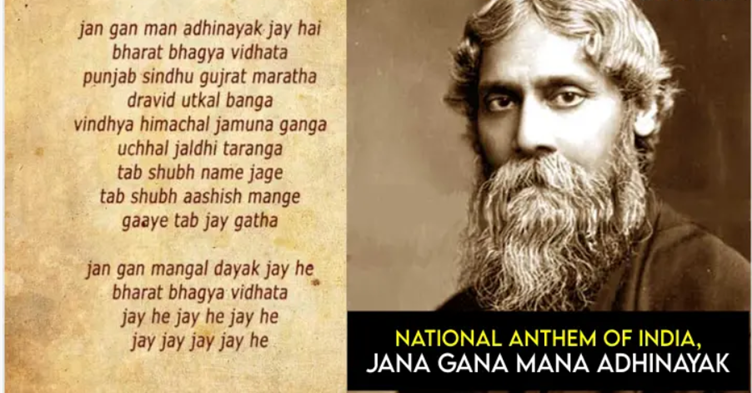
National Song: Vande Mataram
- The song Vande Mataram, composed in Sanskritised Bengali by Bankimchandra Chatterji.
- It was incorporated in his famous Bengali novel Ananda Math (1882).
- It has an equal status with the National Anthem.
- Later the song was set to tune by Rabindranath Tagore.
- It was sung for the first time at the annual session of the Indian National Congress held in 1896 at Calcutta.
- It was declared as the National Song in 1937 through a resolution.
- The English translation of the stanza was rendered by Sri Aurobindo.
- It was a source of inspiration to the people in their struggle for freedom.
- A speech by Dr Rajendra Prasad in the Constituent Assembly on 24 January 1950 stated that “the historical role played by Vande Mataram in the battle for Indian liberation, must be honored equally with Jana Gana Mana, it shall have equal standing with it.”
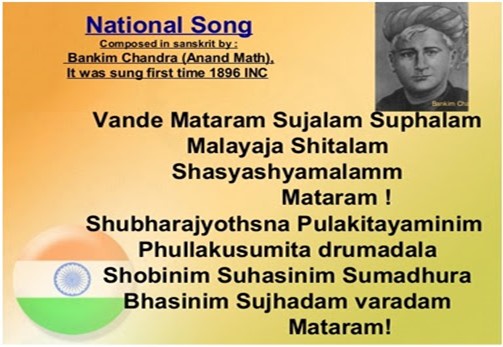
National Currency: Indian Rupee
- Currently, the Indian rupee (ISO code: INR) is used as the country’s official currency.
- The Reserve Bank of India issues currency in the country.
- As of 2010, the Latin letter “R” has been used as an Indian rupee symbol instead of the “र” (also pronounced as “ra”) consonant of the Devanagari alphabet.
- The symbol “₹” is an amalgamation of Devanagari "Ra" and the Roman Capital "R".
- With two parallel horizontal stripes, they are running at the top representing the national flag and also the "equal to" sign.
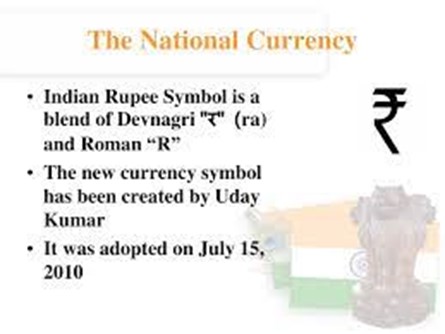
- Udaya Kumar Dharma lingam came up with the concept for it.
- The equality sign appears because of the country’s objective to eliminate economic inequality.
- The equality sign appears on the INR.
- INR’s design was chosen from a group of five symbols previously submitted for consideration.
- The pattern is based on Indian tricolor.
- The symbol was conceptualized and designed by Udaya Kumar, a post graduate in Design from Indian Institute of Technology Bombay.
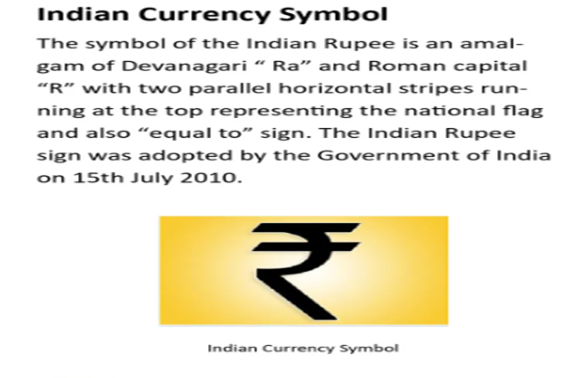
National River: Ganga River
- Ganga River or Ganges River was declared as the National River of India on November 4, 2008, by the Indian Prime Minister Manmohan Singh.
- Since then, it has been a part of the National Symbols of India.
- The Ganga or Ganges is the longest river of India flowing over 2,510 kms of mountains, valleys and plains.
- It originates in the snowfields of the Gangotri Glacier in the Himalayas as the Bhagirathi River.
- It is later joined by other rivers such as the Alaknanda, Yamuna, Son, Gumti, Kosi and Ghagra.
- The Ganga River basin is one of the most fertile and densely populated areas of the world and covers an area of 1,000,000 sq. kms.
- There are two dams on the river - one at Haridwar and the other at Farakka.
- The Ganga is revered by Hindus as the most sacred river on earth.
- Key religious ceremonies are held on the banks of the river at cities such as Varanasi, Haridwar and Allahabad.
- The Ganga widens out into the Ganges Delta in the Sunderbans swamp of Bangladesh, before it ends its journey by emptying into the Bay of Bengal.
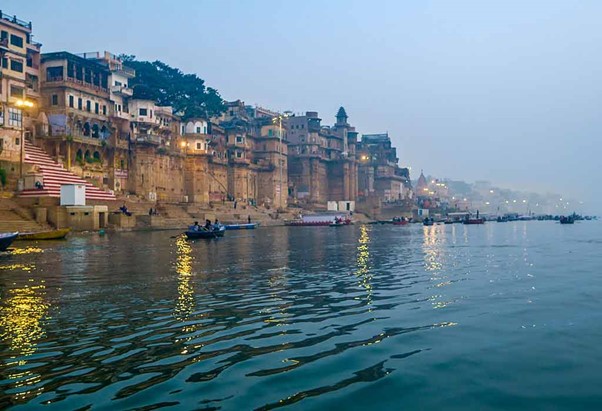
Leave a Reply
Your Comment is awaiting moderation.


